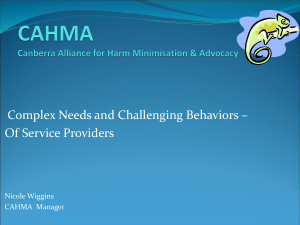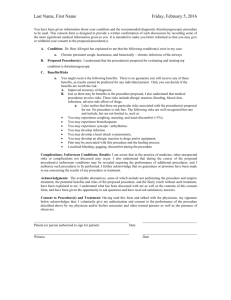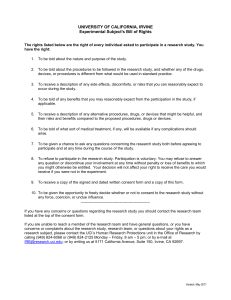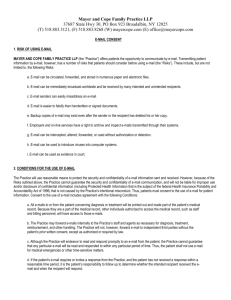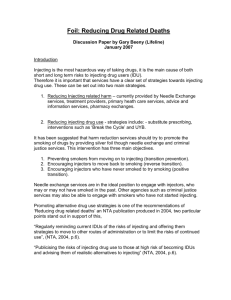Needle Exchange for Young People under 18 years of age
advertisement
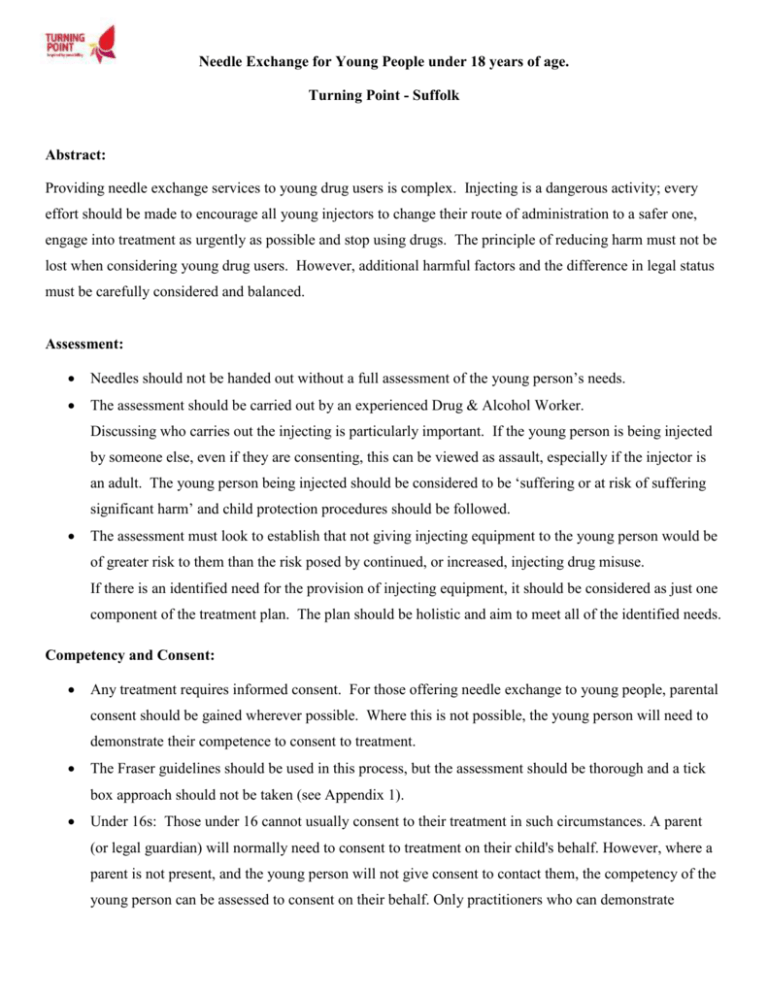
Needle Exchange for Young People under 18 years of age. Turning Point - Suffolk Abstract: Providing needle exchange services to young drug users is complex. Injecting is a dangerous activity; every effort should be made to encourage all young injectors to change their route of administration to a safer one, engage into treatment as urgently as possible and stop using drugs. The principle of reducing harm must not be lost when considering young drug users. However, additional harmful factors and the difference in legal status must be carefully considered and balanced. Assessment: Needles should not be handed out without a full assessment of the young person’s needs. The assessment should be carried out by an experienced Drug & Alcohol Worker. Discussing who carries out the injecting is particularly important. If the young person is being injected by someone else, even if they are consenting, this can be viewed as assault, especially if the injector is an adult. The young person being injected should be considered to be ‘suffering or at risk of suffering significant harm’ and child protection procedures should be followed. The assessment must look to establish that not giving injecting equipment to the young person would be of greater risk to them than the risk posed by continued, or increased, injecting drug misuse. If there is an identified need for the provision of injecting equipment, it should be considered as just one component of the treatment plan. The plan should be holistic and aim to meet all of the identified needs. Competency and Consent: Any treatment requires informed consent. For those offering needle exchange to young people, parental consent should be gained wherever possible. Where this is not possible, the young person will need to demonstrate their competence to consent to treatment. The Fraser guidelines should be used in this process, but the assessment should be thorough and a tick box approach should not be taken (see Appendix 1). Under 16s: Those under 16 cannot usually consent to their treatment in such circumstances. A parent (or legal guardian) will normally need to consent to treatment on their child's behalf. However, where a parent is not present, and the young person will not give consent to contact them, the competency of the young person can be assessed to consent on their behalf. Only practitioners who can demonstrate competence to work with young injecting drug users should assess competence to consent to needle exchange. 16 and 17-year-olds: Those aged 16 and 17 years are usually considered able to consent to treatment, but comprehensive assessments should still be used for this age group to ensure the decision is individual. Safeguarding issues will still need to be considered and responded to, and it is still good practice to involve parents wherever possible. Confidentiality: Needle Exchange services are conducted within a framework of confidentiality. Young People using the service should have the confidentiality policy explained to them before any assessment. Confidentiality should only be breached without consent when it is believed to be in the best interests of the young person. If a decision has been made to breach confidentiality, the young person should have this decision explained to them, wherever possible prior to the disclosure. See Appendix 2 for the four parameters to consider when establishing whether to disclose confidential information from a young person. Needle Exchange Services: The provision of needles to under 18s should be carried out by local drug treatment services and not through Pharmacy Needle Exchange Schemes. However, pharmacy providers should be given all the necessary information so that they are confident in referring under 18s to local young people’s services. If the adult service provided needle, then ideally an alternative venue should be found. However, if this is not possible, then the young person should be given a specific appointment time rather than attend a general drop-in session. Staff providing needles to under 18s will ideally be both experienced in working with young people with substance misuse problems and in needle exchange procedures and harm minimisation (see Appendix 3 for the necessary competencies). Where a young person's drug & alcohol worker does not have these skills, they should be supported by a worker from the adult service with experience of needle exchange. Provision of Needles: Needle exchange for young people requires a high standard of monitoring, including thorough recording of all decision-making and information sharing. An inspection of injecting sites to take place before the provision of injecting paraphernalia; both to ensure that the young person is injecting and to assess if the technique is adequate or if any treatment is required. Consent is required to examine the young person’s body. This inspection should take place in the presence of another worker of the same gender as the young person. Injection sites in intimate parts of the body (any sites that are only accessible by the removal of clothing) should be inspected by a doctor or registered nurse. Do not assume that the young person has a good knowledge of the risks of injecting. Ensure that the young person is given all the relevant information (see Appendix 4). Limit the provision of needles and paraphernalia amounts for personal use (subject to assessment of regularity of use and next use of the exchange). Needle exchanges should occur on a frequent basis, i.e. several times a week if possible. Recommended reading: British Medical Association (2001) Consent, rights and choices in health care for children and young people. London: BMJ Publishing Group. Gilmore, S. and Herring, J. (2011) 'No' is the hardest word: consent and children's autonomy. Child and Family Law Quarterly, 23(1): 3-25. McFarlane, A. (2011) Mental capacity: one standard for all ages. Family Law, 41(5): 479-485. Taylor, R. (2007) Reversing the retreat from Gillick? R (Axon) v Secretary of State for Health. Child and Family Law Quarterly, 19(1): 81-97. Wheeler, R. (2006) Gillick or Fraser? A plea for consistency over competence in children: Gillick and Fraser are not interchangeable. British Medical Journal, 332(7545): 807. Miller, W and Rollnick, S (2012) Motivational Interviewing; helping people change. Guildford Press. Appendix 1 Fraser Guidelines (Mental Health Act 1983 Code of Practice, 1999) Young people under 16 years of age have a right to confidential medical advice and treatment provided: that the young person understands the advice and has the maturity to understand what is involved; that the doctor/health professional cannot persuade the young person to inform parents/carers with parental responsibility, nor allow the doctor to inform them; that the young person's physical and/or mental health will suffer if they do not have treatment; that it is in the young person's best interests to give such advice/treatment without parental consent; that, in the case of contraception or substance misuse, the young person will continue to put themselves at risk of harm if they do not have advice/treatment. Please see appendix 5 for a competency checklist. Appendix 2 The following four parameters are a guide for practitioners and managers in establishing whether to disclose confidential information from a young person to social services, police, NSPCC or other relevant services. 1. The age and maturity of the child. As a general rule, the younger the child, the more problematic it is to guarantee or maintain confidentiality. There is no age limit in law below which a child cannot enter into a confidential relationship, but given the problems of establishing competence to consent to treatment, it is difficult to envisage children being offered confidential treatment for drug misuse, without parental consent or parental involvement, much under the age of 13. Indeed, it is possible that a failure to inform parents that a young child is misusing drugs could lead to legal negligence action if the drug service or agency failed to take sufficient action to protect the child from harm as a result of that drug misuse. 2. The degree of seriousness of drug misuse. The more serious the drug (or substance) misuse, the more likely it is that disclosure of confidential information to other agencies (NSPCC, social services, police) will have to be considered. In deciding whether to disclose, the drug service must take into account: the patterns and levels of drug taking; the risks of morbidity; mortality; and other risks such as involvement in crime and other behaviour linked with the substance misuse. The supply source of the child's drugs may also be important, particularly if the child is 'at risk' of exploitation or coercion. 3. Whether harm or risk is continuing or increasing. Harm from drug taking needs to be assessed with consideration of past, present and potential future behaviour. If there is a clear risk to the child arising from present behaviour or evidence of an escalation of risk such that the child is or is likely to, suffer significant harm, it is important that a service takes steps to ensure the future safety of the child. If the child or young person has multiple problems, it is likely that other agencies or professionals will need to be involved to resolve these problems or reduce the child's vulnerability to risk of harm. Examples would be: a child who reveals abuse within their home or residential setting; the child who has fallen out with his or her parents and is homeless; the child who has absconded from care. In such cases, the child or young person needs to be encouraged to involve other agencies. The drug service will need to assess the child's circumstances and determine whether to disclose confidential information against the child's wishes. Appendix 3 Staff working with under 18s should know and be able to demonstrate these skills: Communication and engagement skills with young people, especially with young people who may be 'hard to engage.' An awareness of local children's specialist services, including those with child protection responsibilities, and when and how to refer. Understanding when to inform parents and/or the local authority. Knowledge of the law relating to the principles of confidentiality and the need to disclose information in certain circumstances. Ability to contribute to the development of young people's drug services. An in-depth knowledge of child and adolescent development; understanding the implications of major events such as abuse, bereavement and other traumatic incidents in the lives of children and young people. The ability to conduct assessments based on the guidance Framework for Assessment of Children in Need and their Families (Department of Health et al. 2000) Understanding the issues of confidentiality and consent to treatment that involve the rights of children and the responsibilities of parents and professionals. Assessment skills - being able to assess the severity and risks of substance misuse, the complexity of a planned intervention and the competence of a young person to consent to treatment. Ability to manage and work within the Area Child Protection Committees child protection guidelines (Child Protection Act 2004) and to understand the relationship between substance misuse and the vulnerability of children and young people. To be able to demonstrate compliance with the relevant sections of the Drug and Alcohol National Occupational Standards (DANOS). Needle exchange competencies would include: Establish whether service users are injecting, what substances and the frequency of injecting. Provide advice on safe or safer injecting techniques and sites. Provide relevant and timely advice on primary health care, safer sex and harm minimisation including prevention of overdose, promoting hepatitis B vaccination, viral testing and preventing initiation into injecting. Provide advice and resources for the safer disposal of injecting equipment. Dispense injecting equipment and condoms in line with the service user assessment. Implement needle exchange policies and procedures. Liaise and work with providers of pharmacy-based syringe schemes in line with policies and protocols, e.g. helping them respond to under 18-year-olds needs. Ensure adequate stocks of equipment. Monitor and evaluate needle exchange service provision. Appendix 4 It is important to correct any harmful injecting and preparing techniques in order to reduce harm, as well as discussing all the health risks associated with sharing equipment and the consequences of being infected with a blood-borne virus. Mention the following information: Injury through unsafe injecting techniques. Specific drugs that are less safe for injecting (i.e. tablets). The heightened risk of overdose. Paying attention to personal safety (i.e. not injecting alone). Possible abuse, exploitation or injury that may occur in connection with (or as a result of) intoxication and/or dependency. Discuss not only what infections may be transmitted, but also how they may affect a young person’s health. Provide information on the testing and vaccination options available. Appendix 5 Checklist for Competence Are you satisfied that the young person understands the advice you are giving? Comment: Yes / No Have you done all you can to encourage the young person to inform parents or guardians? Comment: Yes / No Have you determined that the young person’s best interests are served by offering advice or treatment without parental consent? Comment: Yes / No Are you satisfied that the young person is likely to begin or continue injecting without the use of our needle exchange service? Comment: Yes / No Are you satisfied that the young person’s physical or mental health is likely to suffer unless they receive advice or treatment? Comment: Yes / No Is it in the young person’ best interest to give needle exchange advice or service? Comment: Yes / No Is the young person living with parents or others? Comment: Yes / No Are there any specific concerns or issues (e.g. Mental health, self-harm, etc.)? Comment: Yes / No Worker name................................................ Signature.......................................................... Date...................... Client name.................................................. Signature.......................................................... Date......................



